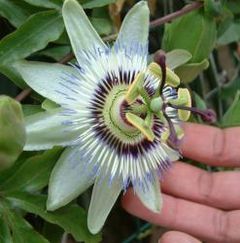Passifloraceae facts for kids
Quick facts for kids Passifloraceae |
|
|---|---|
 |
|
| Passiflora caerulea | |
| Scientific classification | |
| Kingdom: | |
| Division: | |
| Class: | |
| Order: | |
| Family: |
Passifloraceae
Juss. ex Kunth
|
| Genera | |
|
See text |
|
The Passifloraceae are a fascinating family of flowering plants. You might know them better as the passion flower family! There are about 530 different types of plants in this group, found in around 18 main categories called genera.
These plants come in many forms, including trees, shrubs, and lianas (which are woody vines). Many are climbing plants that love to grow upwards. Most of them live in warm, tropical parts of the world.
Contents
What are Passion Flowers?
The most famous members of the Passifloraceae family are the passion flowers, which belong to the genus Passiflora. These plants are well-known for their truly unique and often very colorful flowers. They can look quite exotic!
Where Do They Grow?
Passion flowers and their relatives mostly live in tropical and subtropical areas. This means you'll find them in places with warm weather all year round. Many species are native to the Americas, especially Central and South America. Some also grow in parts of Asia, Australia, and Africa.
They often thrive in forests, where they can climb up trees to reach the sunlight. You might also see them growing in gardens because people love their beautiful flowers.
Amazing Flowers and Fruits
The flowers of Passifloraceae plants are truly special. They have a complex structure that makes them stand out.
Flower Design
A typical passion flower has five petals and five sepals (which look like petals). But what makes them unique is a crown of colorful filaments, called the corona, inside the flower. This corona can be very bright and patterned.
The center of the flower usually has five stamens (the parts that make pollen) and three stigmas (the parts that receive pollen). This unique design helps certain animals pollinate them.
Pollination and Reproduction
Many different creatures help passion flowers reproduce. Bees, butterflies, and even hummingbirds are attracted to the bright colors and sweet nectar of the flowers. When these animals visit a flower, they pick up pollen and carry it to another flower, helping the plant make seeds.
After successful pollination, the flowers develop into fruits. These fruits contain the seeds of the plant.
Passion Fruit: A Tasty Treat
One of the most popular fruits from this family is the passion fruit. It comes from several species of Passiflora, especially Passiflora edulis.
What Does it Taste Like?
Passion fruit is usually round or oval and can be purple or yellow when ripe. Inside, it has a juicy, jelly-like pulp filled with small, edible seeds. The taste is often described as sweet and tart, with a strong, tropical flavor.
How People Use Passion Fruit
People enjoy passion fruit in many ways. You can eat it fresh by scooping out the pulp. It's also used to make delicious juices, smoothies, desserts, and even jams. It adds a wonderful tropical flavor to many dishes.
Other Uses of Passifloraceae
Besides their beautiful flowers and tasty fruits, some plants in this family have other uses.
Ornamental Plants
Because of their stunning flowers, many passion flower species are grown as ornamental plants. This means people plant them in gardens, parks, and even indoors to make places look pretty. They can grow on trellises, fences, or walls, creating a lovely display.
Traditional Uses
In some cultures, certain parts of Passifloraceae plants have been used in traditional medicine. For example, some species are believed to have calming properties. However, it's important to remember that using plants for medicine should always be done carefully and with expert advice.
See also
 In Spanish: Pasifloráceas para niños
In Spanish: Pasifloráceas para niños

